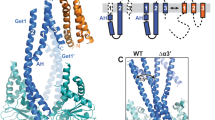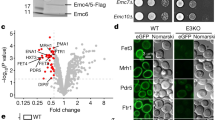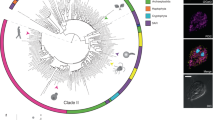Abstract
Hundreds of tail-anchored proteins, including soluble N-ethylmaleimide-sensitive factor attachment receptors (SNAREs) involved in vesicle fusion, are inserted post-translationally into the endoplasmic reticulum membrane by a dedicated protein-targeting pathway1,2,3,4. Before insertion, the carboxy-terminal transmembrane domains of tail-anchored proteins are shielded in the cytosol by the conserved targeting factor Get3 (in yeast; TRC40 in mammals)5,6,7. The Get3 endoplasmic-reticulum receptor comprises the cytosolic domains of the Get1/2 (WRB/CAML) transmembrane complex, which interact individually with the targeting factor to drive a conformational change that enables substrate release and, as a consequence, insertion8,9,10,11. Because tail-anchored protein insertion is not associated with significant translocation of hydrophilic protein sequences across the membrane, it remains possible that Get1/2 cytosolic domains are sufficient to place Get3 in proximity with the endoplasmic-reticulum lipid bilayer and permit spontaneous insertion to occur12,13. Here we use cell reporters and biochemical reconstitution to define mutations in the Get1/2 transmembrane domain that disrupt tail-anchored protein insertion without interfering with Get1/2 cytosolic domain function. These mutations reveal a novel Get1/2 insertase function, in the absence of which substrates stay bound to Get3 despite their proximity to the lipid bilayer; as a consequence, the notion of spontaneous transmembrane domain insertion is a non sequitur. Instead, the Get1/2 transmembrane domain helps to release substrates from Get3 by capturing their transmembrane domains, and these transmembrane interactions define a bona fide pre-integrated intermediate along a facilitated route for tail-anchor entry into the lipid bilayer. Our work sheds light on the fundamental point of convergence between co-translational and post-translational endoplasmic-reticulum membrane protein targeting and insertion: a mechanism for reducing the ability of a targeting factor to shield its substrates enables substrate handover to a transmembrane-domain-docking site embedded in the endoplasmic-reticulum membrane.
This is a preview of subscription content, access via your institution
Access options
Subscribe to this journal
Receive 51 print issues and online access
$199.00 per year
only $3.90 per issue
Buy this article
- Purchase on Springer Link
- Instant access to full article PDF
Prices may be subject to local taxes which are calculated during checkout




Similar content being viewed by others
References
Denic, V., Dötsch, V. & Sinning, I. Endoplasmic reticulum targeting and insertion of tail-anchored membrane proteins by the GET pathway. Cold Spring Harb. Perspect. Biol. 5, a013334 (2013)
Denic, V. A portrait of the GET pathway as a surprisingly complicated young man. Trends Biochem. Sci. 37, 411–417 (2012)
Hegde, R. S. & Keenan, R. J. Tail-anchored membrane protein insertion into the endoplasmic reticulum. Nature Rev. Mol. Cell Biol. 12, 787–798 (2011)
Chartron, J. W., Clemons, W. M., Jr & Suloway, C. J. M. The complex process of GETting tail-anchored membrane proteins to the ER. Curr. Opin. Struct. Biol. 22, 217–224 (2012)
Stefanovic, S. & Hegde, R. S. Identification of a targeting factor for posttranslational membrane protein insertion into the ER. Cell 128, 1147–1159 (2007)
Schuldiner, M. et al. The GET complex mediates insertion of tail-anchored proteins into the ER membrane. Cell 134, 634–645 (2008)
Favaloro, V., Spasic, M., Schwappach, B. & Dobberstein, B. Distinct targeting pathways for the membrane insertion of tail-anchored (TA) proteins. J. Cell Sci. 121, 1832–1840 (2008)
Wang, F., Whynot, A., Tung, M. & Denic, V. The mechanism of tail-anchored protein insertion into the ER membrane. Mol. Cell 43, 738–750 (2011)
Stefer, S. et al. Structural basis for tail-anchored membrane protein biogenesis by the Get3-receptor complex. Science 333, 758–762 (2011)
Mariappan, M. et al. The mechanism of membrane-associated steps in tail-anchored protein insertion. Nature 477, 61–66 (2011)
Kubota, K., Yamagata, A., Sato, Y., Goto-Ito, S. & Fukai, S. Get1 stabilizes an open dimer conformation of get3 ATPase by binding two distinct interfaces. J. Mol. Biol. 422, 366–375 (2012)
Borgese, N. & Fasana, E. Targeting pathways of C-tail-anchored proteins. Biochim. Biophys. Acta 1808, 937–946 (2011)
Leznicki, P., Warwicker, J. & High, S. A biochemical analysis of the constraints of tail-anchored protein biogenesis. Biochem. J. 436, 719–727 (2011)
Wang, F., Brown, E. C., Mak, G., Zhuang, J. & Denic, V. A chaperone cascade sorts proteins for posttranslational membrane insertion into the endoplasmic reticulum. Mol. Cell 40, 159–171 (2010)
Brandman, O. et al. A ribosome-bound quality control complex triggers degradation of nascent peptides and signals translation stress. Cell 151, 1042–1054 (2012)
Richards, F. M. & Vithayathil, P. J. The preparation of subtilisin-modified ribonuclease and the separation of the peptide and protein components. J. Biol. Chem. 234, 1459–1465 (1959)
Li, J. et al. Reactions of cysteines substituted in the amphipathic N-terminal tail of a bacterial potassium channel with hydrophilic and hydrophobic maleimides. Proc. Natl Acad. Sci. USA 99, 11605–11610 (2002)
Akopian, D., Shen, K., Zhang, X. & Shan, S. Signal recognition particle: an essential protein-targeting machine. Annu. Rev. Biochem. 82, 693–721 (2013)
Park, E. & Rapoport, T. A. Mechanisms of Sec61/SecY-mediated protein translocation across membranes. Annu. Rev. Biophys. 41, 21–40 (2012)
Martin, A., Baker, T. A. & Sauer, R. T. Rebuilt AAA + motors reveal operating principles for ATP-fuelled machines. Nature 437, 1115–1120 (2005)
Brachmann, C. B. et al. Designer deletion strains derived from Saccharomyces cerevisiae S288C: a useful set of strains and plasmids for PCR-mediated gene disruption and other applications. Yeast 14, 115–132 (1998)
Tong, A. H. et al. Systematic genetic analysis with ordered arrays of yeast deletion mutants. Science 294, 2364–2368 (2001)
Denic, V. & Weissman, J. S. A molecular caliper mechanism for determining very long-chain fatty acid length. Cell 130, 663–677 (2007)
Joglekar, A. P., Salmon, E. D. & Bloom, K. S. Counting kinetochore protein numbers in budding yeast using genetically encoded fluorescent proteins. Methods Cell Biol. 85, 127–151 (2008)
Acknowledgements
We thank O. Brandman and R. Hegde for reagents, members of the Denic laboratory for scientific advice, and J. Weissman, A. Murray, B. Stern and C. Patil for comments on the manuscript. This work was supported by the National Institutes of Health (RO1GM0999943-01) and a postdoctoral fellowship from the Sara Elizabeth O’Brien Trust Postdoctoral Fellowship Program, Bank of America, Co-Trustee (to F.W.).
Author information
Authors and Affiliations
Contributions
F.W. performed most of the experiments described in the study. C.C. analyzed Get1 cysteine N-ethylmaleimide (NEM) accessibility. N.R.W. performed cell microscopy experiments. F.W., C.C., N.R.W. and V.D. examined the data. V.D. conceived the project, guided the experiments, and wrote the paper with F.W. and input from C.C. and N.R.W.
Corresponding author
Ethics declarations
Competing interests
The authors declare no competing financial interests.
Extended data figures and tables
Extended Data Figure 1 Get1/2 cytosolic domains and tail-anchored trap work together to prevent substrate re-binding to Get3.
a, Top: schematic illustrating how tail-anchored trap but not mock trap drives substrate release from Get3 in the presence of miniGet1/2. Bottom: affinity-purified Get3–Sec22 was incubated at room temperature for 30 min with the indicated concentrations of miniGet1/2 in the presence of either excess tail-anchored trap (Sgt2ΔN) or mock trap (Sgt2ΔC)8 followed by crosslinking as in Fig. 1c. b, Schematic showing how Get1/2 activity can be monitored in vivo using a transcriptional GFP reporter.
Extended Data Figure 2 Get1/2 TMD mutations used in this study.
a, Schematic of Get2-1sc and transmembrane swap mutants used in this study. Ost4 TMD (Nlumen-Ccyto) containing a mutation that abolishes its interaction with other components of the OST complex was used to replace Get1/2 transmembranes that have the same topology. Sec61-β TMD was used to replace the indicated Get1/2 transmembranes of opposite topology. b, ClustalW2 alignment of numbered amino-acid sequences corresponding to the Get2 TM3 (ΔG prediction server version 1.0) from the indicated fungal homologues (Sc, Saccharomyces cerevisiae; Cg, Candida glabrata; Ss, Scheffersomyces stipites; Sp, Schizosaccharomyces pombe) and human calcium-modulating cyclophilin ligand (CAML). Aligned positions were colour-coded by Jalview and the degree of conservation is shown below as a sequence consensus histogram. Asterisk indicates 100% conservation of Get2Sc D271.
Extended Data Figure 3 Genetic disruption of the TMD of Get1/2 causes a general defect in substrate release from Get3.
a, Affinity-purified Get3–Sec22 was incubated with the indicated microsomes and analysed by Sec22 insertion analysis as in Fig. 1b. b, Affinity-purified Get3–Sec22 was incubated with the indicated microsomes or mock-incubated and analysed by crosslinking analysis as in Fig. 1c. c, Left: the hydrophobicity of the indicated TMD sequences was calculated using the ΔG prediction server version 1.0. Right: affinity-purified Get3–Sec61-β was incubated with the indicated microsomes followed by crosslinking analysis as in Fig. 1c.
Extended Data Figure 4 Get3 is efficiently recruited to microsomes with a severe genetic disruption of the Get1/2 TMD.
a, Whole-cell lysates from the indicated yeast strains were subjected to SDS–PAGE analysis and visualized by immunoblotting. Hexokinase (HXK) was used as a loading control. b, Recombinant Get3–Flag was incubated with the indicated microsomes and analysed by membrane flotation analysis and immunoblotting as in Fig. 2a.
Extended Data Figure 5 Further in vivo and in vitro analysis of mutant phenotypes associated with Get2TM2-1sc.
a, GFP expression of the heat-shock reporter in the indicated strains was measured by flow cytometry analysis as in Fig. 1a (n = 2). b, Representative confocal microscopy images of Sgt2–mCherry localization in the indicated strains. White arrowheads indicate the presence of cytosolic tail-anchored protein aggregates. c, Equal amounts of microsomes (normalized by D280 nm) were subjected to SDS–PAGE analysis and visualized by immunoblotting. d, The indicated microsomes were solubilized in Triton X-100 detergent or mock-solubilized on ice for 30 min. TEV protease digestion of samples, as indicated, was performed overnight at 4 °C followed by SDS–PAGE analysis and immunoblotting. e, Affinity-purified Get3–Sec22 was incubated with the indicated microsomes and analysed by Sec22 insertion analysis as in Fig. 1b. f, Affinity-purified Get3–Sec22 was incubated with the indicated microsomes or mock-incubated and analysed by crosslinking analysis as in Fig. 1c.
Extended Data Figure 6 Biochemical characterization of Get1/2 transmembrane complexes and proteoliposomes used in Fig. 2b.
a, The indicated samples were affinity-purified by anti-Flag immunoprecipitation and elution with Flag peptide, subjected to SDS–PAGE analysis, and visualized by Coomassie blue staining. b, Following proteoliposome reconstitution with the indicated affinity-purified proteins, membranes were separated from the rest of the material by flotation analysis followed by centrifugation of the low-density fraction. The resulting purified proteoliposomes were subjected to SDS–PAGE analysis and visualized by Coomassie blue staining.
Extended Data Figure 7 Defining Get1/2 transmembrane Cys positions that interact with tail-anchored proteins.
a, Cells expressing the indicated single-cysteine alleles of Get1 and Get2 from their endogenous genetic loci and the indicated control cells were subjected to heat-shock reporter analysis as in Fig. 1a (n = 2). b, Cell extracts containing Get3–Sec22S192C were incubated with S protein followed by the addition of the indicated microsomes for 15 min at room temperature and crosslinking analysis as in Fig. 3c. Samples were denatured with SDS (an ionic detergent) and diluted into immunoprecipitation buffer with Triton X-100 (a non-ionic detergent) before pull-down with anti-Flag resin. Eluted material was subjected to SDS–PAGE analysis and visualized by immunoblotting and autoradiography. c, Get3–Sec22S192Cs was road-blocked with S protein and incubated with the indicated microsomes followed by crosslinking analysis as in Fig. 3c.
Extended Data Figure 8 Insertase-disrupting mutation prevents Get1/2 TMD interactions with pre-integrated tail-anchored proteins.
a, Affinity-purified Get3–Sec22S192Cs was road-blocked with S protein and incubated with the indicated microsomes for subsequent crosslinking analysis as in Fig. 3c. b, NEM alkylation or mock treatment of the indicated microsomes was followed by NEM quenching and membrane solubilization in SDS. The denatured samples were subjected to PEG-maleimide alkylation, as indicated. Alkylation was quenched and samples were subjected to SDS–PAGE analysis and visualized by immunoblotting. Get2-1scPEG indicates the PEGylated form of Get2-1sc. Quantitation revealed that the cysteine accessibility factor of T15C was 0.97 for Get2-1sc and 0.52 for Get2-1TM3msc. Thus, the lack of Sec22S192C crosslinking to Get2-1TM3sc (T15C) (Extended Data Fig. 8a) is unlikely owing to cysteine inaccessibility. c, Affinity-purified Get3–Sec22S192Cs was road-blocked with S protein for 10 min at room temperature or mock-treated before incubation with Get1T15C microsomes for the indicated amounts of time. Samples were simultaneously subjected to Sec22 insertion and crosslinking analysis as in Figs 1b and 3c, respectively. On the right is a kinetic analysis plot of the gel data shown on the left. XL indicates the amount of crosslinked product between Get1 and Sec22. d, Affinity-purified Get3–Sbh1L58Cs was incubated with the indicated microsomes at room temperature for 5 min. Samples were simultaneously subjected to substrate insertion and crosslinking analysis as in Figs 1b and 3c, respectively. e, Cell extracts containing Get3–Sbh1L158Cs were incubated with the indicated microsomes for 5 min at room temperature and crosslinking/immunoprecipitation analysis as in Extended Data Fig. 7b.
Supplementary information
Supplementary Information
This file contains a Supplementary Discussion. (PDF 80 kb)
Rights and permissions
About this article
Cite this article
Wang, F., Chan, C., Weir, N. et al. The Get1/2 transmembrane complex is an endoplasmic-reticulum membrane protein insertase. Nature 512, 441–444 (2014). https://doi.org/10.1038/nature13471
Received:
Accepted:
Published:
Issue Date:
DOI: https://doi.org/10.1038/nature13471
This article is cited by
-
The ER membrane protein complex restricts mitophagy by controlling BNIP3 turnover
The EMBO Journal (2023)
-
Evolutionary balance between foldability and functionality of a glucose transporter
Nature Chemical Biology (2022)
-
Structural and molecular mechanisms for membrane protein biogenesis by the Oxa1 superfamily
Nature Structural & Molecular Biology (2021)
-
The WRB Subunit of the Get3 Receptor is Required for the Correct Integration of its Partner CAML into the ER
Scientific Reports (2019)
-
The Ways of Tails: the GET Pathway and more
The Protein Journal (2019)
Comments
By submitting a comment you agree to abide by our Terms and Community Guidelines. If you find something abusive or that does not comply with our terms or guidelines please flag it as inappropriate.



